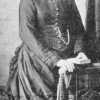Frances’ death at her home in Poole on the 17th of June 1856 was not unexpected. It marked the end of a two year battle with cancer, which had attacked her womb. She was the daughter of James and Frances (nee Besant) Davis; the sister of Rachel, Elizabeth, Thomas and Leah; the wife of James; the mother of Rachel, Emily, Henrietta and Tom and a grandmother as well.
Until the cancer came her last twenty years had been settled and comfortable but it had not always been so. Frances Davis, sometimes known as Fanny, attracted men who lacked commitment. Her husband of 22-years was not her first and he was the father of only one of her children; Henrietta, who was baptised on the 17th of November 1824 at St. Mary’s church, Sturminster Marshall; her mother had been baptised there 26-years earlier on the 4th of February 1798.
Frances got James Boyt to the altar of the village church on the 3rd of August 1834, 10-years after the birth of their daughter. The Sturminster Marshall Overseers had issued a bastardy order against James and at the time of their marriage he knew the village constable held a warrant for his arrest for not supporting his child. James Boyt may have concluded it would be cheaper to make an honest woman of Frances rather than pay 10-years arrears of child support or spend a term in jail. However, from this distance it would be unfair to label this a marriage of convenience for James Boyt was taking on rather more than a wife and a daughter.
By now Frances was the mother of three other children. Rachel baptised on the 2nd of March 1818, just eight months after the marriage of her mother to James Ford on the 3rd of August 1817. Emily, baptised on the 4th of March 1821, “the daughter of Fanny Ford” after James Ford had run away from his responsibilities. Then there was Tom Ford born in 1829; he was the subject of a bastardy order against a William Medway of Wimborne.
In 1841 James Boyt was living with his wife and step-son, at King Street, Sturminster Marshall; their daughter Henrietta was with her grandparents (Davis) in the High Street. Frances’ eldest girl, Rachel, was working as a servant at West Brooks Farm, Shapwick, which is about two miles away from her home village. Emily was at Poole where she was working as a servant for hotel-keeper William Furmage. Similarly employed at the hotel was Ann Davis; Emily and Ann were probably cousins.
A decade later the family moved to Poole and with help from the 1851 census we can drop in on the family to see how they are all getting on. James and Frances have moved to West Quay, Poole and Tom Ford is still with them. James and Tom are both working as farm labourers. Their daughter, Henrietta, is in Poole and described as a Cook’s Shopkeeper. She is unmarried and has a one-year-old daughter. On the day of the census she had the company of two visitors Eliza Smith (18) and Julia Peiler (16), both shirt makers.
Emily married John Henry Chitty in the early part of 1843 in the Wimborne district and that includes Sturminster Marshall, which suggests her mother and step-father moved to Poole after that event. John Chitty came from Shaftesbury; in 1881 the couple had a nine-acre farm at South Stoneham, Hampshire.
Rachel was a green grocer at Thames Street, Poole. She had a two-year-old daughter, Georgina, born at Hamworthy. In the census she is listed as Rachel Ford and lets the enumerator believe she is a widow but there is no evidence to say she had been married.
On the 7th of February 1860, Rachel, then 42, married Samuel Betts, a master mariner of High Street, Poole; the marriage was witnessed by her sister Emily Chitty. In 1861 Rachel and Samuel Betts have Rachel’s twelve-year-old daughter Georgina with them and they are at Thames Street, carrying on business as grocers. Samuel came from Maldon in Essex and was six-years younger than his wife who was buried at Poole on the 1st of June 1896 and a year, almost to the day, later Samuel Betts was buried there on the 6th of June 1897. We loose track of Henrietta and her daughter.
In the summer of 1856 Tom marries Sarah Medway in the Poole district and by 1861 they have settled at Lytchett Minster. Interestingly, the bastardy order of which Tom was the subject cited William Medway as the father; Sarah’s father was a William Medway. The 1861 census has the couple at Sydney Place, Lytchett Minster, with two children, William and Emily, but from the 1871 census, when the couple are living at Poole Road, Lytchett Minster, we can see that both children died. By 1881 Tom and Sarah, then living at Yarrels Common, have six children: Sarah (19); William (16);
Mary (13); Bessie (11), and Harry (6). Also with them is Sarah’s mother, Eliza Medway (76); she receives a pension. Eliza Medway was buried on the 28th of January 1882 at Lytchett Minster.
Tom Ford died and was buried at Lytchett Minster on the 19th of August 1889; his widow continued to live with two of her sons, William and Harry, at Lytchett Minster. Living on her own means in 1901 at The Common, Lytchett Minster, her eldest and unmarried son William, then 37, is with her.
By 1891 Emily and her husband John Chitty had moved back to Dorset and in 1901 are living at 23 Church Street, Poole with Ann Dunford, a middle-aged spinster.
James and Frances stayed together for 22-years and for much of this time James’ step-son, Tom was living and working with him. The other children kept in touch. After Frances’ death, ten years passed before James married his second wife, 49-year-old widow Elizabeth Galton and by then James had taken to the sea for employment. James died at Poole in the first quarter of 1873 when his age was given as 68 but he would have been 71-years-of-age.
We shall never know how much James was influenced to marry Frances by the constable waving an arrest warrant but there is little doubt their marriage stood the test of time and all of Frances’ children prospered.



